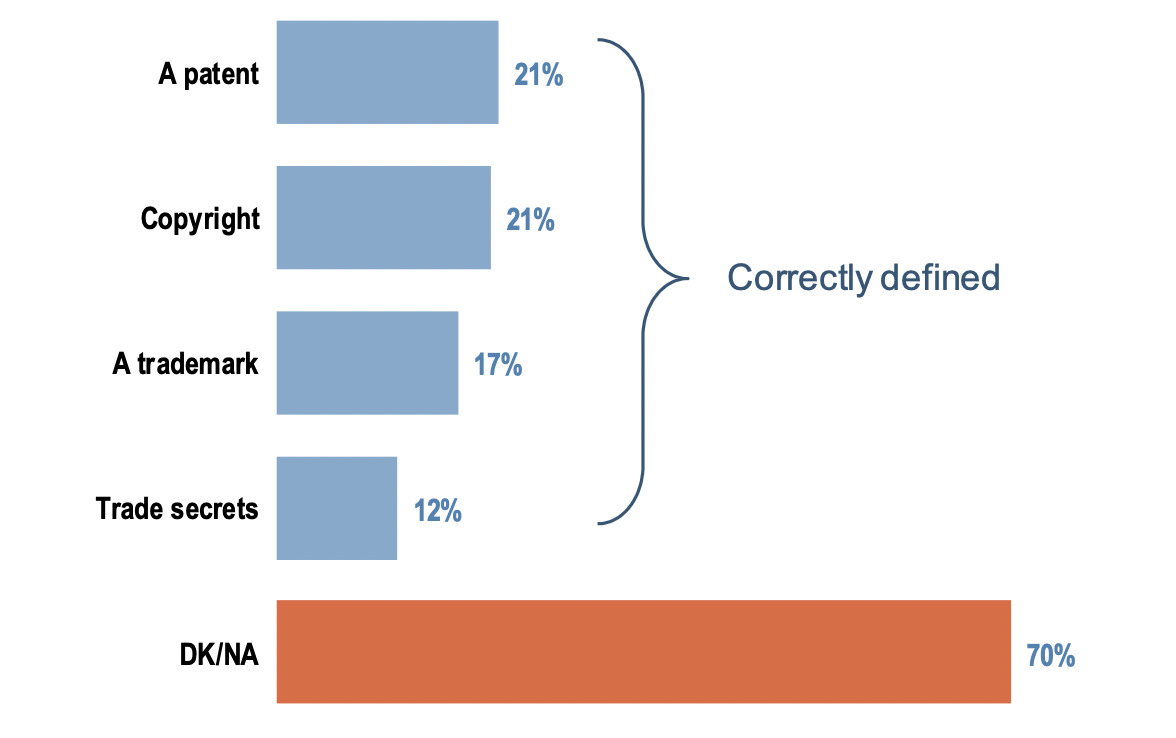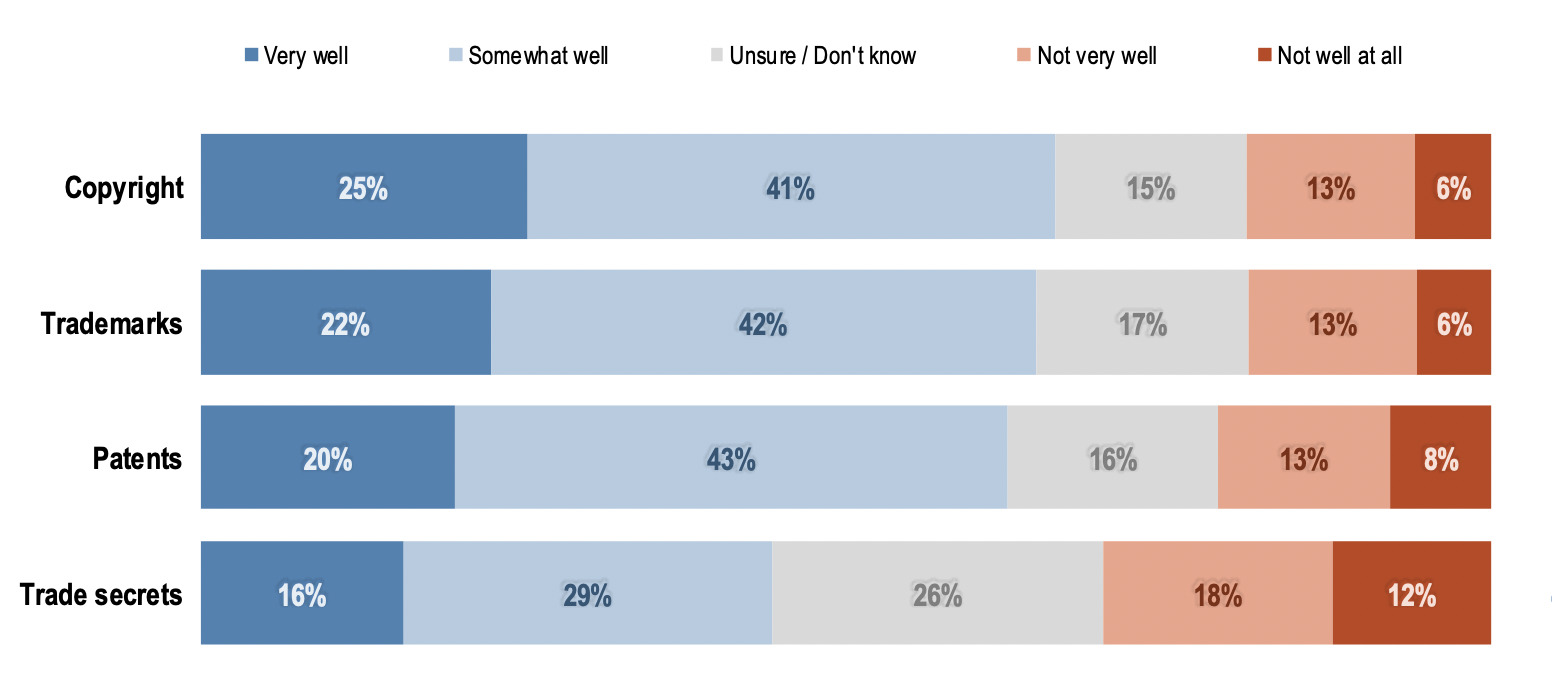“Less than one-third of the survey’s respondents knew that the U.S. Patent and Trademark Office can invalidate a patent previously upheld in federal court, and 81% of respondents either hadn’t read anything about patent law in the media or weren’t sure.”
 Yesterday, the United States Intellectual Property Alliance (USIPA) issued the results of a nationwide survey designed to determine the level of intellectual property awareness among American adults. Perhaps unsurprisingly, USIPA’s survey found that, while most American believed they understood IP, seven out of 10 survey respondents could not identify examples of intellectual property when asked. This new research should add new urgency to the efforts of IP advocates who are trying to increase participation in the U.S. IP system.
Yesterday, the United States Intellectual Property Alliance (USIPA) issued the results of a nationwide survey designed to determine the level of intellectual property awareness among American adults. Perhaps unsurprisingly, USIPA’s survey found that, while most American believed they understood IP, seven out of 10 survey respondents could not identify examples of intellectual property when asked. This new research should add new urgency to the efforts of IP advocates who are trying to increase participation in the U.S. IP system.
Seventy Percent of Respondents Cannot Identify Examples of Intellectual Property
Although 66% of respondents to USIPA’s survey believed that they understood what various forms of IP protected, 70% of respondents were unable to provide examples of IP protections. Though levels of IP understanding recorded by the survey were low, respondents generally held a positive view of intellectual property’s impacts on society. Fifty-two percent of respondents indicated that IP had a completely positive impact, while another 26% of respondents said that IP’s impact on society was more positive than negative.

America’s Understanding of IP Differences: Respondents were asked to describe the difference between a patent, copyright, trademark and trade secret. 70% of respondents were not able to write anything. The content of those who answered was compared to the correct definitions. Many were able to correctly explain patents and copyrights, but fewer were able to describe trademarks and trade secrets. (Images from USIPA report, captions courtesy of Bruce Berman)
Interestingly, most respondents appeared to have a better view of patents’ positive impacts on society than other forms of IP. Only 41% of respondents to the USIPA survey felt that copyrights and trademarks definitely had a positive impact on society, despite their respective roles in supporting the media and entertainment industries and protecting against U.S. consumers buying fake, possibly dangerous counterfeits. Though sentiment regarding patent law may have been fonder, the American public’s understanding of the patent law landscape is remarkably low. Less than one-third of the survey’s respondents knew that the U.S. Patent and Trademark Office can invalidate a patent previously upheld in federal court, and 81% of respondents either hadn’t read anything about patent law in the media or weren’t sure if they had read such content.

American Understanding of IP Rights: About two-thirds of Americans say they understand copyright, trademarks and patents at least somewhat well, while only 44% say they understand trade secrets. Copyright registers the highly percentage saying they understand it “very well,” although even this is only 25%. (Images from USIPA report, captions courtesy of Bruce Berman)
Greater Public Understanding of IP’s Positive Impacts Could Address Misguided Narratives
Addressing the low level of IP understanding among American adults has grown even more important in light of several anti-IP narratives that have taken root and are even influencing dialogue at the highest level of our nation’s policies. For example, the waiver of international IP obligations under the Agreement on Trade-Related Aspects of IP Rights (TRIPS Agreement) for COVID-19 vaccines, for example, was pursued by the Biden Administration without public backlash despite no evidence that patents pose a barrier to vaccine access, or the increased risk of dangerous counterfeit vaccines that can no longer be blocked by IP protections.
Battles over march-in rights under the Bayh-Dole Act provide another case in point regarding how misinformation about IP’s impacts can affect patent policy debates. Many lawmakers have recently urged Xavier Becarra, Secretary of the U.S. Department of Health and Human Services, to exercise the government’s march-in rights on pharmaceuticals developed through federally-funded research to reduce drug pricing. These efforts to leverage march-in rights have increased despite studies showing that the tech transfer framework under Bayh-Dole has spurred trillions in economic impact and many life-saving products that would have sat undeveloped without Bayh-Dole as law. Controversial data sets from policy institutes like the Initiative for Medicines, Access & Knowledge (I-MAK), which have been criticized for opaque methodologies and discrepancies with other public sources of patent data, further underscore why it is important for the the American public to gain a better understanding of intellectual property and its actual impacts on society.
Increasing participation in the IP system is one way through which IP advocates can help ensure that a wider swath of the public gains more understanding through personal experience. “IP rights are about building bridges, not erecting barriers,” said Bruce Berman, Chairman of the Center for Intellectual Property Understanding. “The survey is the product of a multi-disciplinary effort started several years ago to identify the accuracy of what the American public actually knows about IP. The data will help to focus education activities needed to dispel misinformation and foster a conducive environment.”
USIPA’s Founder, Chairman and President, Scott Frank, added: “If we hope to flourish globally a better appreciation of the value that IP provides business and society is essential.”
Along with conducting the survey, USIPA efforts include creating alliances with IP stakeholders at the state level and local educational programming to raise levels of IP understanding. The results of this survey will be discussed at USIPA’s inaugural meeting taking place this Thursday, October 20, in Atlanta.
USIPA’s board is led by co-chairpersons David Kappos, Former Director of the U.S. Patent and Trademark Office; Judge Paul Michel, Former Chief Judge of the U.S. Court of Appeals for the Federal Circuit; and Joyce Ward, the USPTO’s current Director of Education.
Image source: Deposit Phoitos
Author: Blankstock
Image ID: 53310845

![[IPWatchdog Logo]](https://ipwatchdog.com/wp-content/themes/IPWatchdog%20-%202023/assets/images/temp/logo-small@2x.png)

![[Advertisement]](https://ipwatchdog.com/wp-content/uploads/2024/04/Patent-Litigation-Masters-2024-sidebar-early-bird-ends-Apr-21-last-chance-700x500-1.jpg)

![[Advertisement]](https://ipwatchdog.com/wp-content/uploads/2021/12/WEBINAR-336-x-280-px.png)
![[Advertisement]](https://ipwatchdog.com/wp-content/uploads/2021/12/2021-Patent-Practice-on-Demand-recorded-Feb-2021-336-x-280.jpg)
![[Advertisement]](https://ipwatchdog.com/wp-content/uploads/2021/12/Ad-4-The-Invent-Patent-System™.png)







Join the Discussion
2 comments so far.
Joe Williams
October 18, 2022 02:02 pmDoes the methodology delineate failures by bucket when conflating one IP protection with another? I wonder how much the results would would change when accounting for distinguishing (mutually exclusive) characteristics.
IE: if someone suggested copyright as a trademark with a 20 year protection (ie: patent) then all 3 are deemed failures for that participant.
This is something I have personally witnessed over and over again.
Nonetheless, thank you for sharing.
Model 101
October 18, 2022 11:52 amMany of the IP judges are also in the dark on IP because their heads are are stuck in the sand.
All inventors get is what comes out of their back ends.